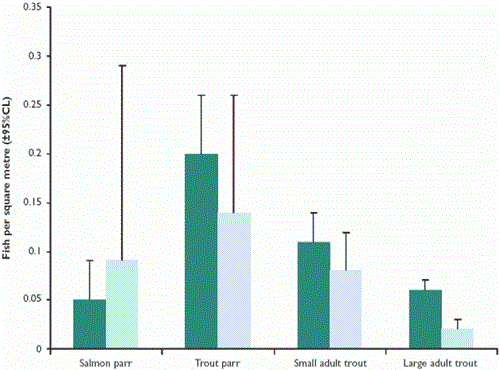Key findings
- Almost as many pike have returned to a previously culled site as were taken out in the initial removal. This happened in seven years and probably as a result of local spawning.
- Pike were less than half the size that they were in the initial removal.
- As yet, this evidence alone does not prove that pike reductions improve numbers of trout.
Pike predation has always been a problem for river keepers and fishery managers trying to maintain and restore trout and salmon fisheries. In the UK netting, electrofishing and rod fishing are typical methods used to remove pike. A study on the upper River Avon in Wiltshire by the Freshwater Biological Association showed that pike removal reduced pike numbers.
From our experience of the upper Avon, some pike are probably left in the river after removal operations and repopulate the river by immigration or breeding. The Centre of Hydrology & Ecology radio-tracking work on the River Frome in Dorset showed that pike move around at times of spawning or flooding. Removing pike is therefore usually an annual task.
From 1993 to 2001 all pike caught by electro-fishing were removed on two kilometres of the River Piddle at Tolpuddle in Dorset. This was done twice a year and, although 32 pike were removed in the first year, after a few years no more than a single fish per year was caught.
Additionally, most of the river up to the source and down to two kilometres below the site had pike removed during the beginning of this period. Thus it could be argued that pike predation was not an issue after the first couple of years in the Tolpuddle site. During this time we showed that trout numbers increased, although later annual growth was reduced (see Review of 2001).
After pike removal stopped in 2002, we monitored 50-metre sections of the site using electro-fishing and, in 2004, some sections had as many as five young pike (with an average length of 216mm). The following year a pike measuring 347mm was caught. So in the autumn of 2007, we went back to the site at Tolpuddle to do a full survey to assess the re-population by pike and to gauge any effects on salmon and trout. We electro-fished the site and measured the densities of salmon and trout along with pike numbers. We also collected length and weight data for all fish. We deduced the age of the pike using a sample of scales from their backs, and we recorded stomach content and maturation.
We found that pike numbers had reached 27, but no fish was bigger than 476mm and 900g. Investigation of the scales showed that the oldest fish was four years old, which confirms the earlier findings of one-year-old fish in 2004, so these fish hatched in 2003. This probably means that these pike are the result of local spawning (brood fish origin is unknown). We also found that the bigger fish had developing gonads, which together with the presence of one-year-old and three-year-old fish, suggested that the pike population was self-sustaining.
Numbers of large trout are now significantly lower than they were during the period of pike removal (see Figure 1). The pike were small and so probably favour predating the smaller salmonids, which raises the question of effects by cormorants or otters known to be present. Bank-side and in-stream habitat in the study area have remained rich throughout the study. Sediment loads in the river have been variable, but good numbers of parr appear every year.
Figure 1: Mean densities of salmon and trout during the period when pike numbers were under control (1997-2000) and seven years after the control had stopped (2007) on the River Piddle, Dorset

Non-significant reductions in smaller trout may be related to the fact that the total biomass of pike is still lower than in 1993, before any pike reductions. The large variation seen for salmon is most likely to be caused by the location of sampling section in relation to spawning activity. We examined pike stomachs and found that only three had prey fish inside them - these were all small trout.